lock GMC JIMMY 2001 User Guide
[x] Cancel search | Manufacturer: GMC, Model Year: 2001, Model line: JIMMY, Model: GMC JIMMY 2001Pages: 443, PDF Size: 2.97 MB
Page 26 of 443
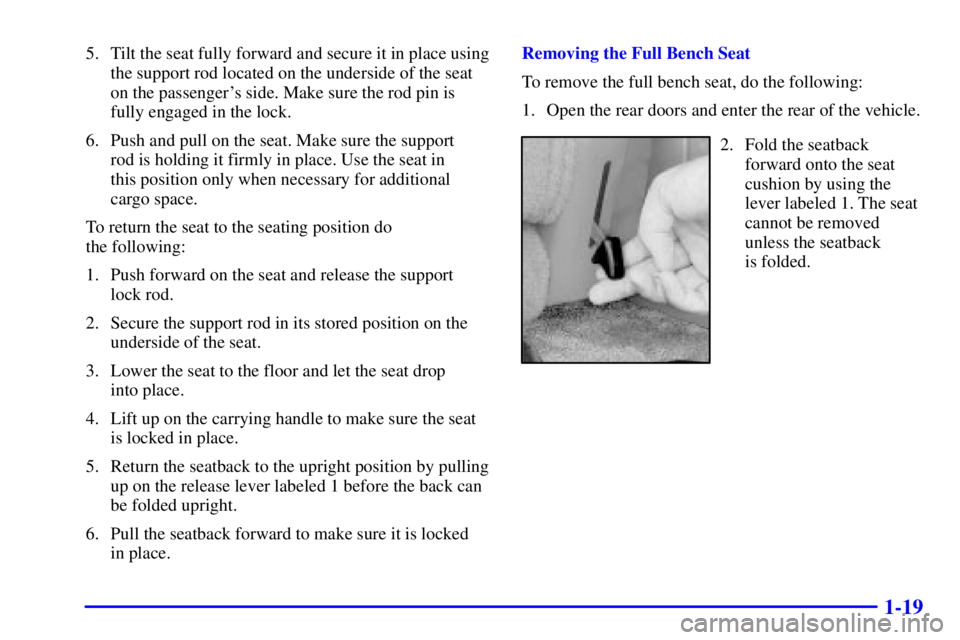
1-19
5. Tilt the seat fully forward and secure it in place using
the support rod located on the underside of the seat
on the passenger's side. Make sure the rod pin is
fully engaged in the lock.
6. Push and pull on the seat. Make sure the support
rod is holding it firmly in place. Use the seat in
this position only when necessary for additional
cargo space.
To return the seat to the seating position do
the following:
1. Push forward on the seat and release the support
lock rod.
2. Secure the support rod in its stored position on the
underside of the seat.
3. Lower the seat to the floor and let the seat drop
into place.
4. Lift up on the carrying handle to make sure the seat
is locked in place.
5. Return the seatback to the upright position by pulling
up on the release lever labeled 1 before the back can
be folded upright.
6. Pull the seatback forward to make sure it is locked
in place.Removing the Full Bench Seat
To remove the full bench seat, do the following:
1. Open the rear doors and enter the rear of the vehicle.
2. Fold the seatback
forward onto the seat
cushion by using the
lever labeled 1. The seat
cannot be removed
unless the seatback
is folded.
Page 27 of 443

1-20
3. To unlatch the seat from
the floor, pull up on the
release lever labeled 2,
located at the rear of the
seat, and lift the rear of
the seat up off the floor.
4. Squeeze the release lever, located in the lower
middle to unlatch the seat from the floor while
pulling the seat out.
5. While holding the rear of the seat up, roll the seat
out of the vehicle.Replacing the Full Bench Seat
CAUTION:
If the seatback isn't locked, it could move forward
in a sudden stop or crash. That could cause injury
to the person sitting there. Always press rearward
on the seatback to be sure it is locked.
CAUTION:
A seat that isn't locked into place properly can
move around in a collision or sudden stop. People
in the vehicle could be injured. Be sure to lock
the seat into place properly when installing it.
Page 28 of 443
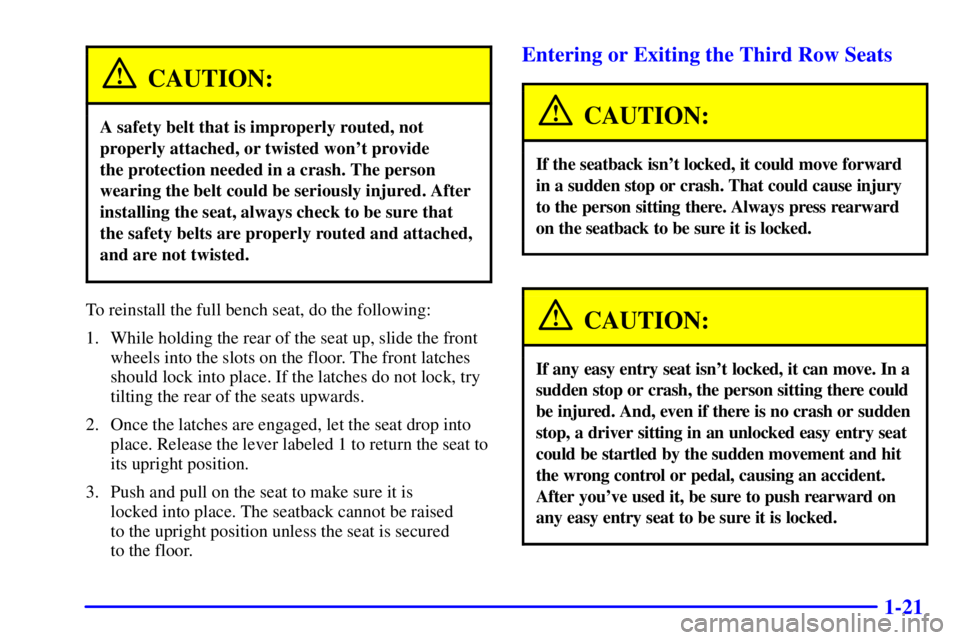
1-21
CAUTION:
A safety belt that is improperly routed, not
properly attached, or twisted won't provide
the protection needed in a crash. The person
wearing the belt could be seriously injured. After
installing the seat, always check to be sure that
the safety belts are properly routed and attached,
and are not twisted.
To reinstall the full bench seat, do the following:
1. While holding the rear of the seat up, slide the front
wheels into the slots on the floor. The front latches
should lock into place. If the latches do not lock, try
tilting the rear of the seats upwards.
2. Once the latches are engaged, let the seat drop into
place. Release the lever labeled 1 to return the seat to
its upright position.
3. Push and pull on the seat to make sure it is
locked into place. The seatback cannot be raised
to the upright position unless the seat is secured
to the floor.
Entering or Exiting the Third Row Seats
CAUTION:
If the seatback isn't locked, it could move forward
in a sudden stop or crash. That could cause injury
to the person sitting there. Always press rearward
on the seatback to be sure it is locked.
CAUTION:
If any easy entry seat isn't locked, it can move. In a
sudden stop or crash, the person sitting there could
be injured. And, even if there is no crash or sudden
stop, a driver sitting in an unlocked easy entry seat
could be startled by the sudden movement and hit
the wrong control or pedal, causing an accident.
After you've used it, be sure to push rearward on
any easy entry seat to be sure it is locked.
Page 29 of 443
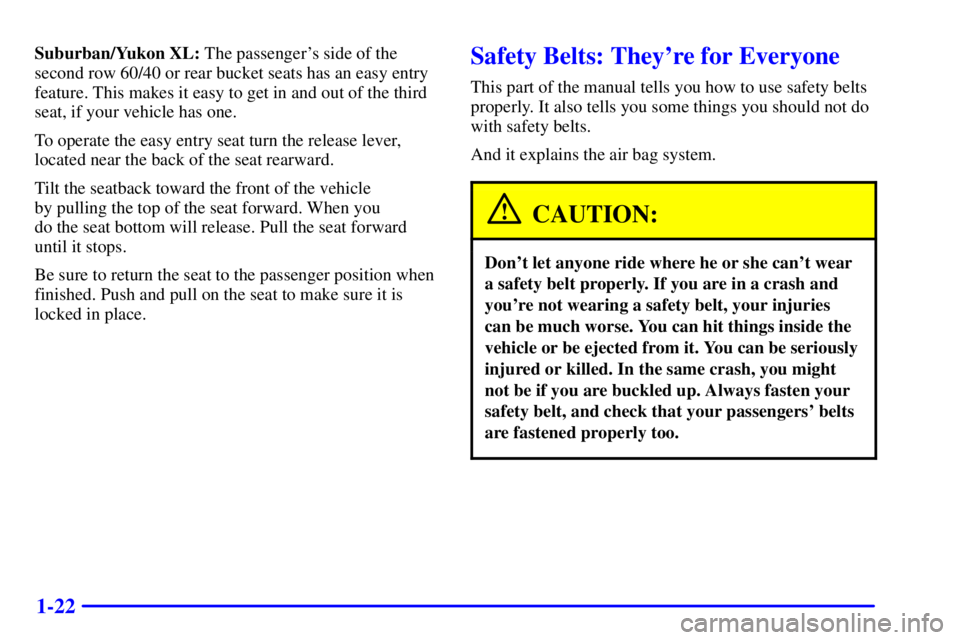
1-22
Suburban/Yukon XL: The passenger's side of the
second row 60/40 or rear bucket seats has an easy entry
feature. This makes it easy to get in and out of the third
seat, if your vehicle has one.
To operate the easy entry seat turn the release lever,
located near the back of the seat rearward.
Tilt the seatback toward the front of the vehicle
by pulling the top of the seat forward. When you
do the seat bottom will release. Pull the seat forward
until it stops.
Be sure to return the seat to the passenger position when
finished. Push and pull on the seat to make sure it is
locked in place.Safety Belts: They're for Everyone
This part of the manual tells you how to use safety belts
properly. It also tells you some things you should not do
with safety belts.
And it explains the air bag system.
CAUTION:
Don't let anyone ride where he or she can't wear
a safety belt properly. If you are in a crash and
you're not wearing a safety belt, your injuries
can be much worse. You can hit things inside the
vehicle or be ejected from it. You can be seriously
injured or killed. In the same crash, you might
not be if you are buckled up. Always fasten your
safety belt, and check that your passengers' belts
are fastened properly too.
Page 35 of 443
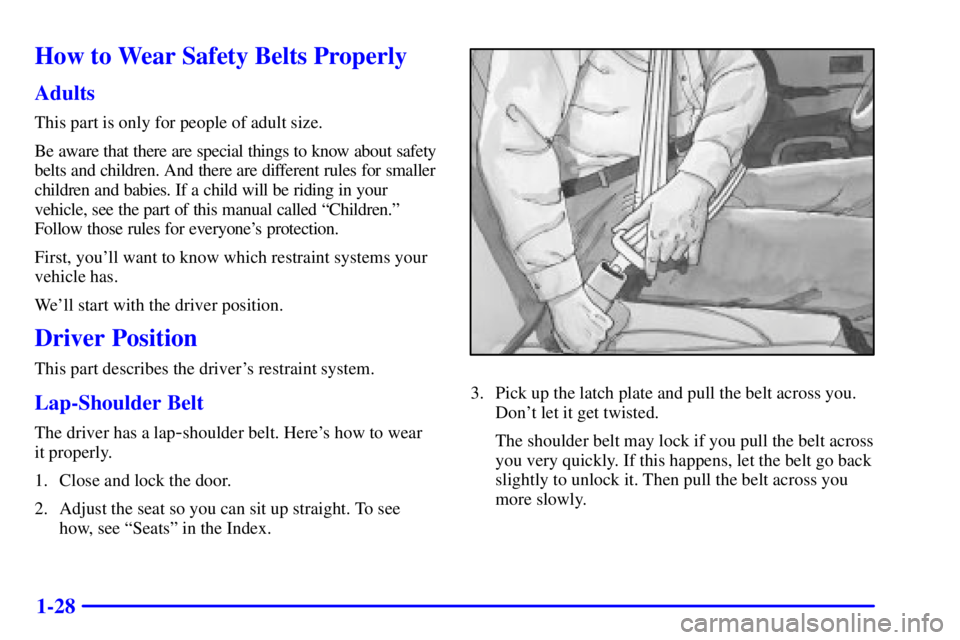
1-28
How to Wear Safety Belts Properly
Adults
This part is only for people of adult size.
Be aware that there are special things to know about safety
belts and children. And there are different rules for smaller
children and babies. If a child will be riding in your
vehicle, see the part of this manual called ªChildren.º
Follow those rules for everyone's protection.
First, you'll want to know which restraint systems your
vehicle has.
We'll start with the driver position.
Driver Position
This part describes the driver's restraint system.
Lap-Shoulder Belt
The driver has a lap-shoulder belt. Here's how to wear
it properly.
1. Close and lock the door.
2. Adjust the seat so you can sit up straight. To see
how, see ªSeatsº in the Index.
3. Pick up the latch plate and pull the belt across you.
Don't let it get twisted.
The shoulder belt may lock if you pull the belt across
you very quickly. If this happens, let the belt go back
slightly to unlock it. Then pull the belt across you
more slowly.
Page 36 of 443
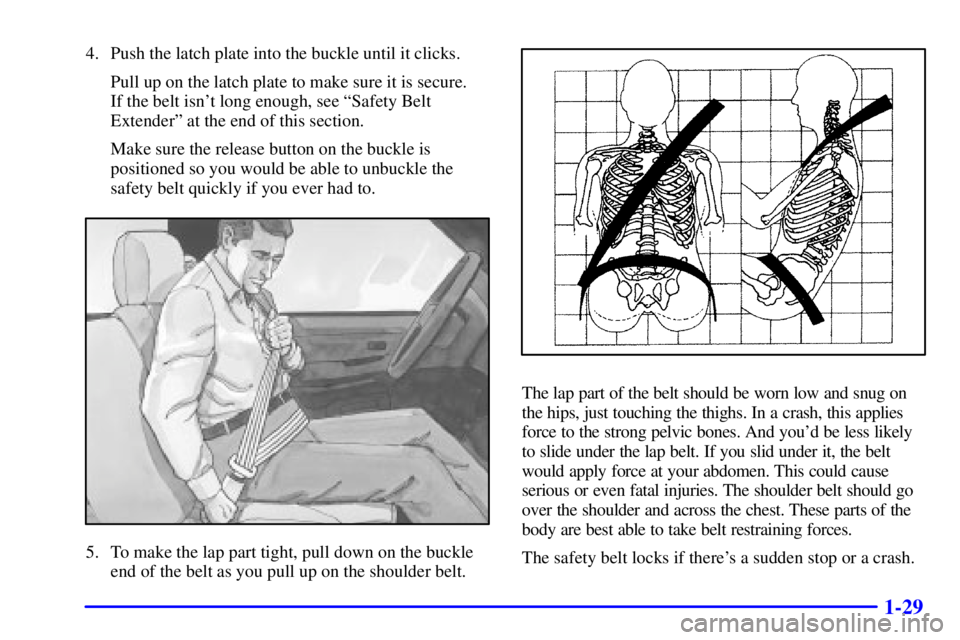
1-29
4. Push the latch plate into the buckle until it clicks.
Pull up on the latch plate to make sure it is secure.
If the belt isn't long enough, see ªSafety Belt
Extenderº at the end of this section.
Make sure the release button on the buckle is
positioned so you would be able to unbuckle the
safety belt quickly if you ever had to.
5. To make the lap part tight, pull down on the buckle
end of the belt as you pull up on the shoulder belt.
The lap part of the belt should be worn low and snug on
the hips, just touching the thighs. In a crash, this applies
force to the strong pelvic bones. And you'd be less likely
to slide under the lap belt. If you slid under it, the belt
would apply force at your abdomen. This could cause
serious or even fatal injuries. The shoulder belt should go
over the shoulder and across the chest. These parts of the
body are best able to take belt restraining forces.
The safety belt locks if there's a sudden stop or a crash.
Page 43 of 443
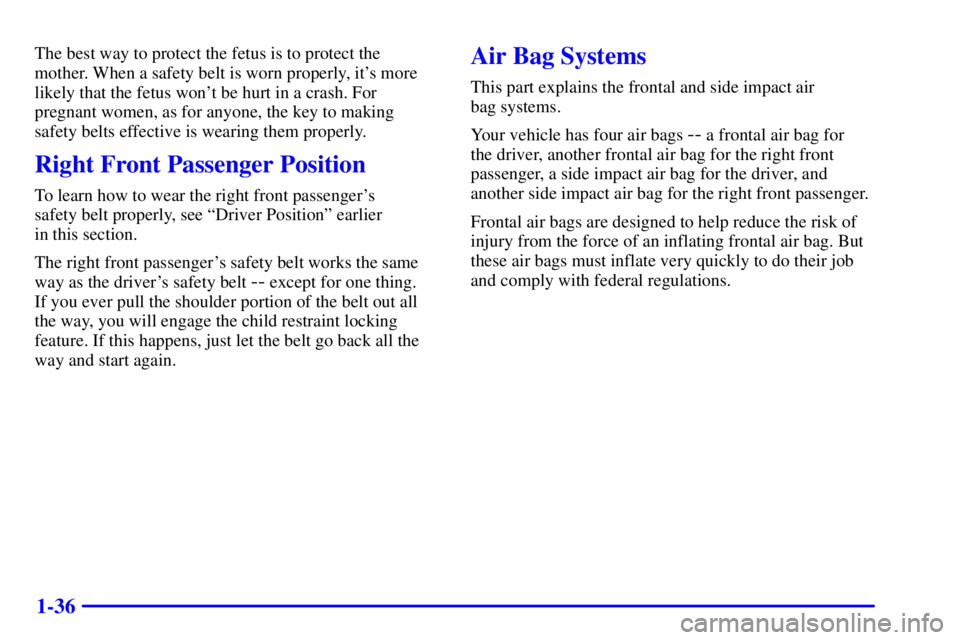
1-36
The best way to protect the fetus is to protect the
mother. When a safety belt is worn properly, it's more
likely that the fetus won't be hurt in a crash. For
pregnant women, as for anyone, the key to making
safety belts effective is wearing them properly.
Right Front Passenger Position
To learn how to wear the right front passenger's
safety belt properly, see ªDriver Positionº earlier
in this section.
The right front passenger's safety belt works the same
way as the driver's safety belt
-- except for one thing.
If you ever pull the shoulder portion of the belt out all
the way, you will engage the child restraint locking
feature. If this happens, just let the belt go back all the
way and start again.
Air Bag Systems
This part explains the frontal and side impact air
bag systems.
Your vehicle has four air bags
-- a frontal air bag for
the driver, another frontal air bag for the right front
passenger, a side impact air bag for the driver, and
another side impact air bag for the right front passenger.
Frontal air bags are designed to help reduce the risk of
injury from the force of an inflating frontal air bag. But
these air bags must inflate very quickly to do their job
and comply with federal regulations.
Page 47 of 443
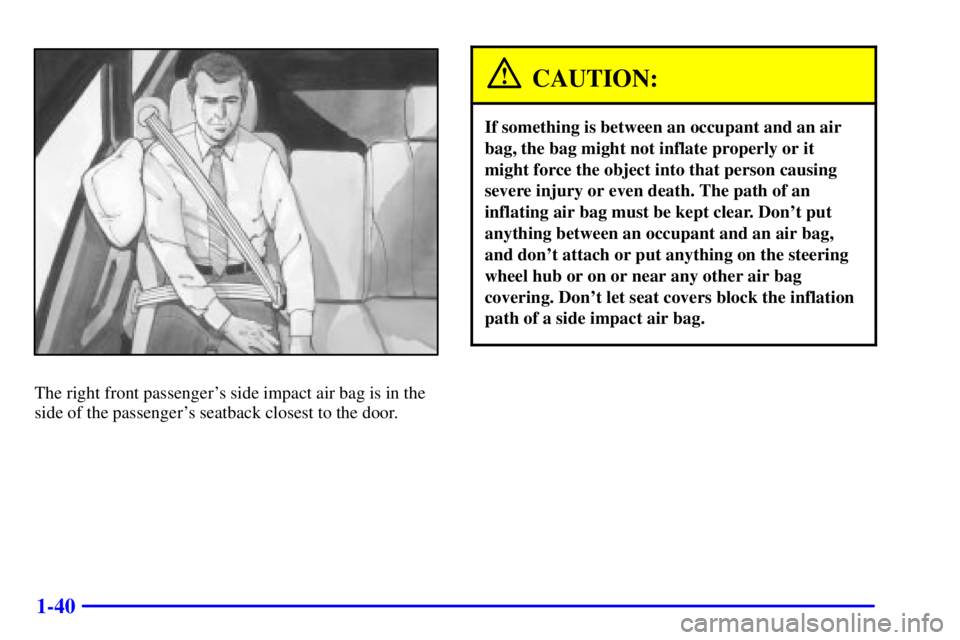
1-40
The right front passenger's side impact air bag is in the
side of the passenger's seatback closest to the door.
CAUTION:
If something is between an occupant and an air
bag, the bag might not inflate properly or it
might force the object into that person causing
severe injury or even death. The path of an
inflating air bag must be kept clear. Don't put
anything between an occupant and an air bag,
and don't attach or put anything on the steering
wheel hub or on or near any other air bag
covering. Don't let seat covers block the inflation
path of a side impact air bag.
Page 56 of 443

1-49
2. Push the latch plate into the buckle until it clicks.
Pull up on the latch plate to make sure it is secure.
When the shoulder belt is pulled out all the way, it
will lock. If it does, let it go back all the way and
start again.
If the belt is not long enough, see ªSafety Belt
Extenderº at the end of this section.
Make sure the release button on the buckle is
positioned so you would be able to unbuckle the
safety belt quickly if you ever had to.
3. To make the lap part tight, pull down on the buckle
end of the belt as you pull up on the shoulder part.
Page 57 of 443

1-50
The lap part of the belt should be worn low and snug on
the hips, just touching the thighs. In a crash, this applies
force to the strong pelvic bones. And you'd be less likely
to slide under the lap belt. If you slid under it, the belt
would apply force at your abdomen. This could cause
serious or even fatal injuries. The shoulder belt should go
over the shoulder and across the chest. These parts of the
body are best able to take belt restraining forces.
The safety belt locks if there's a sudden stop or a crash.
CAUTION:
You can be seriously hurt if your shoulder belt is
too loose. In a crash, you would move forward
too much, which could increase injury. The
shoulder belt should fit against your body.
To unlatch the belt, just push the button on the buckle.